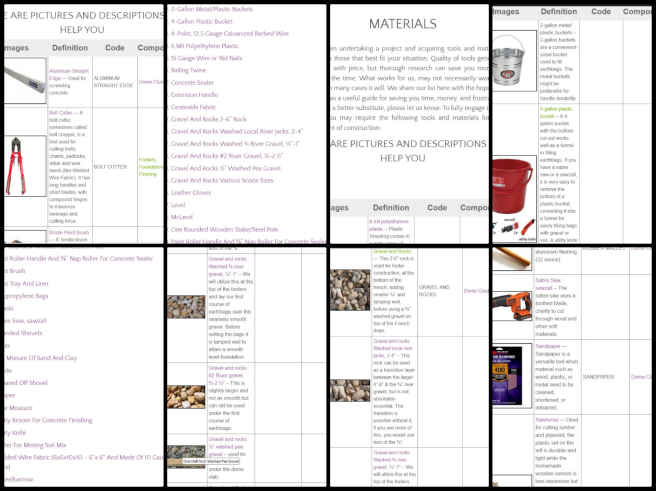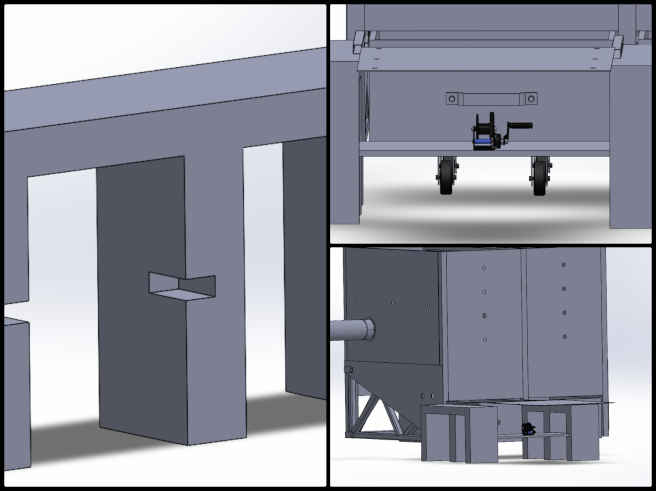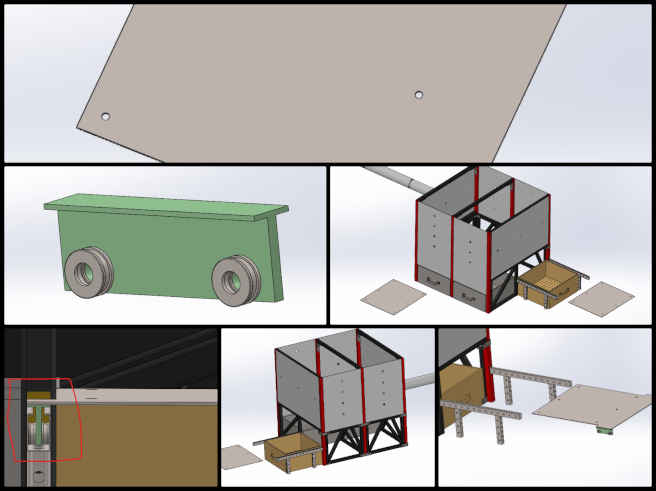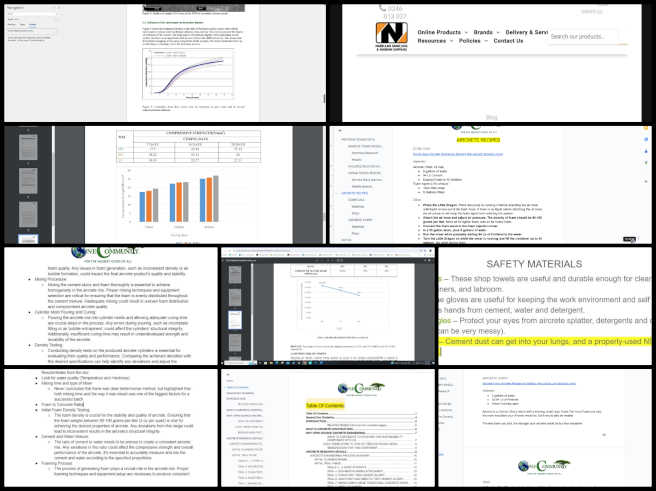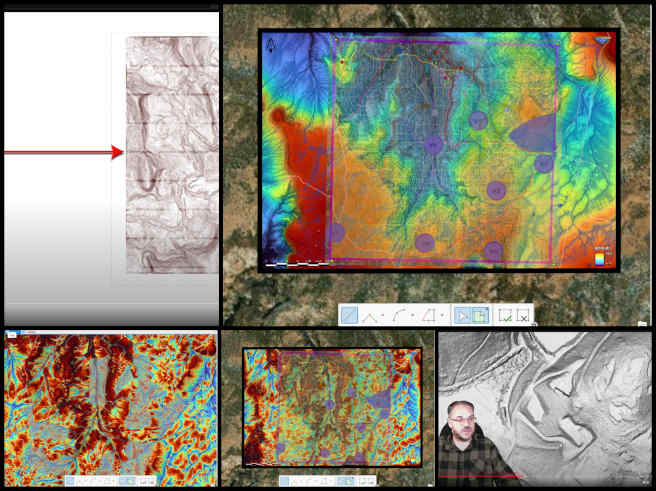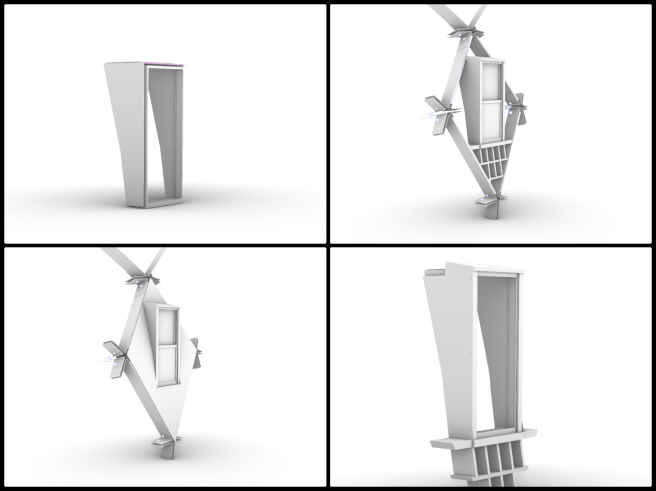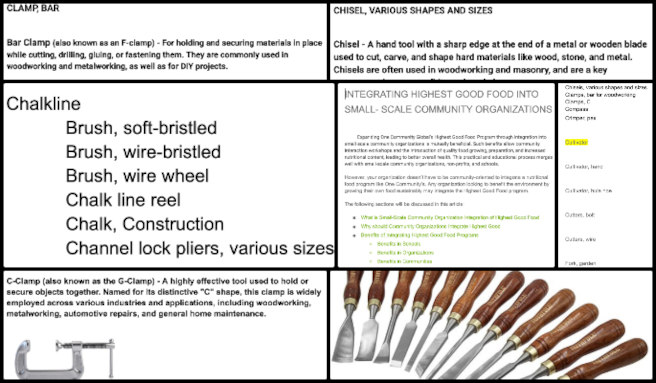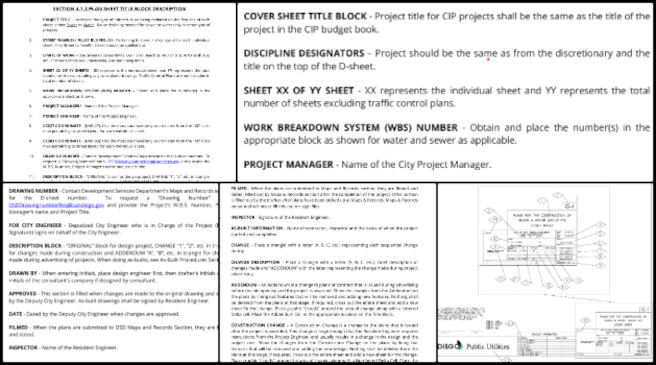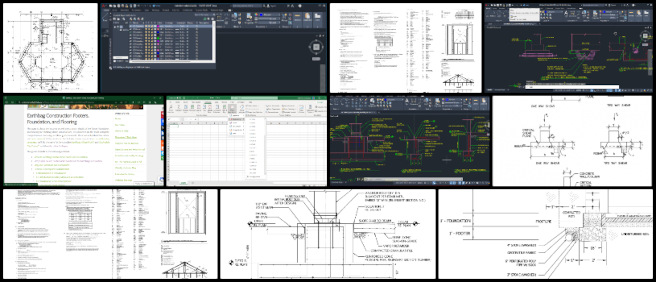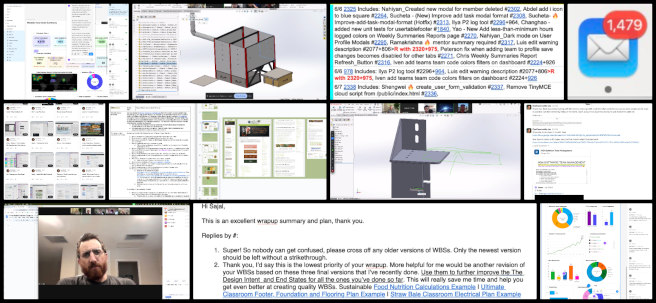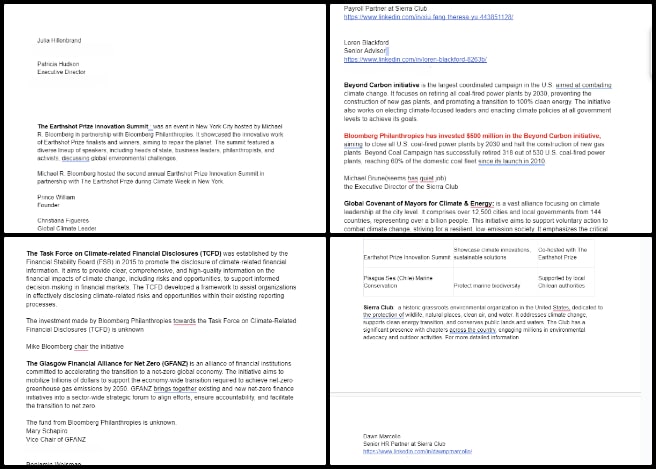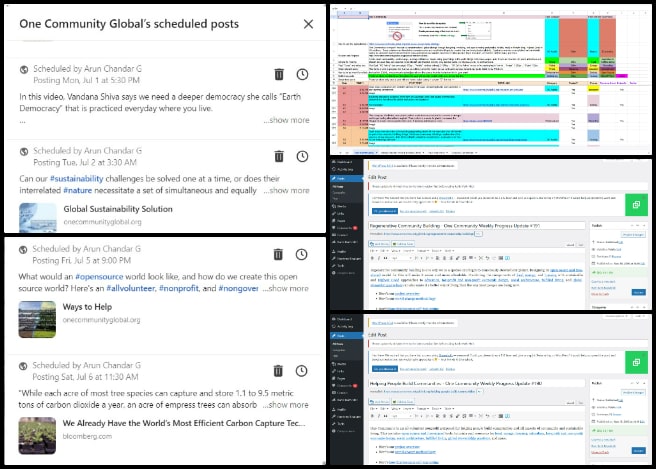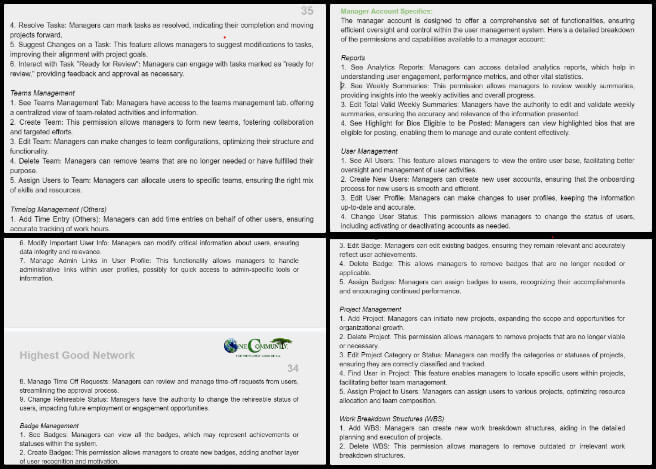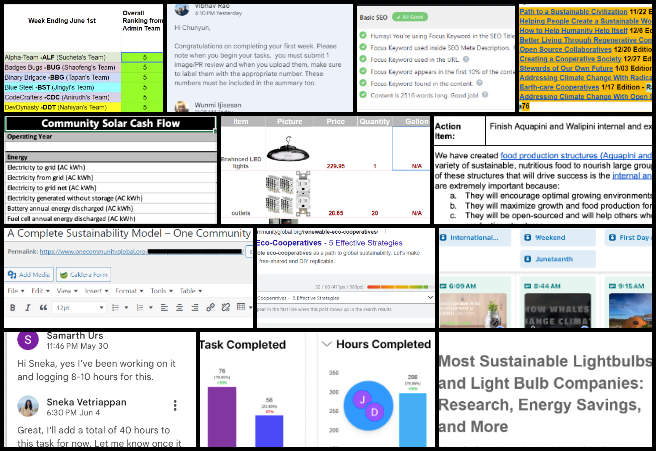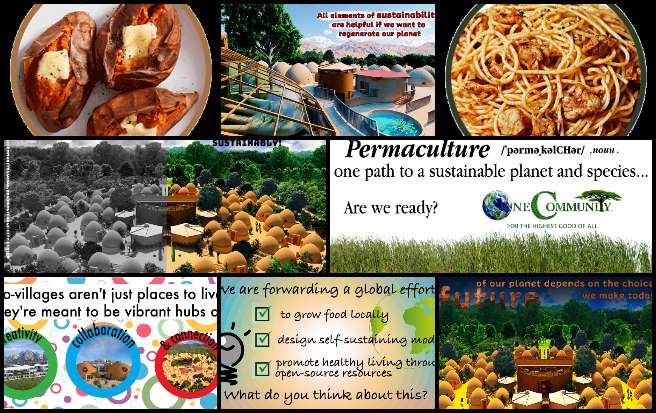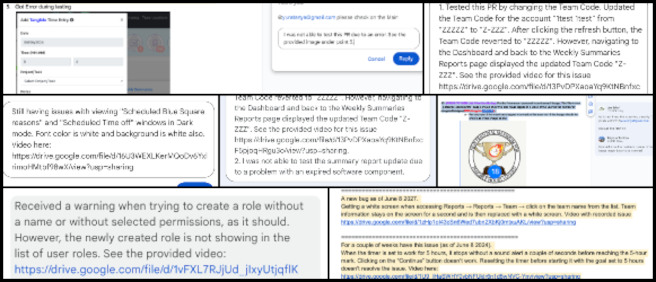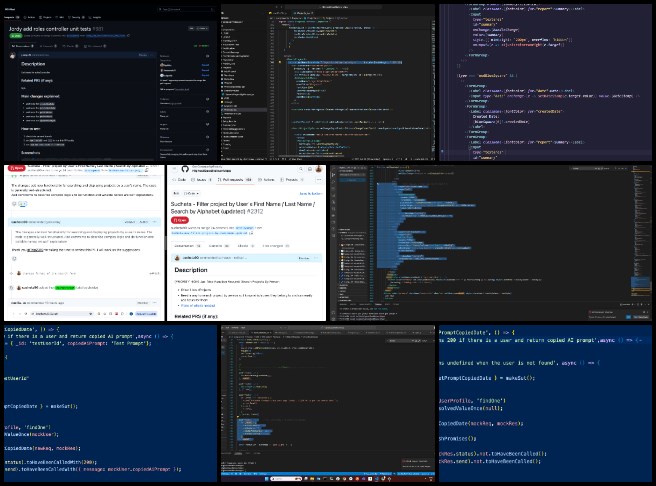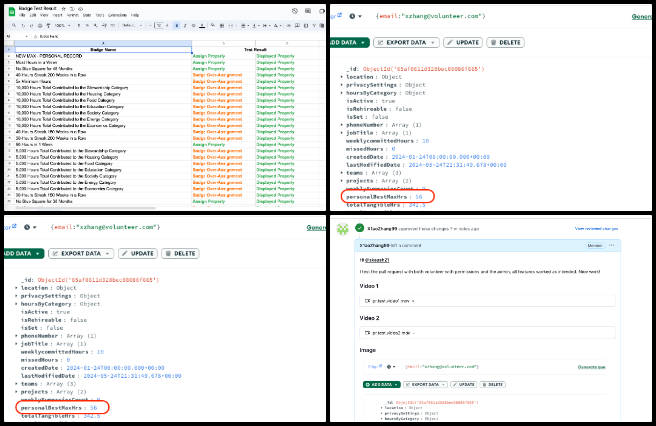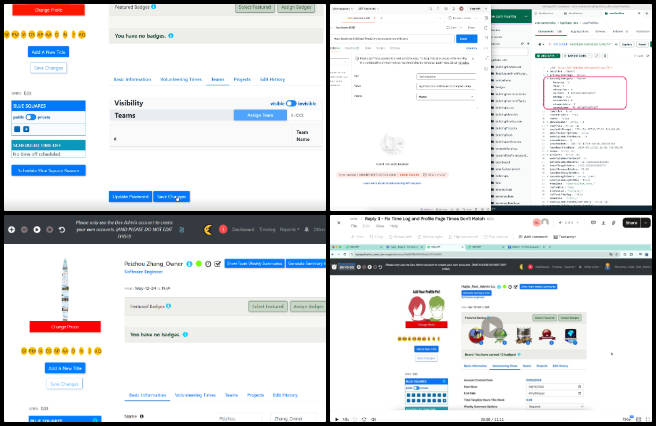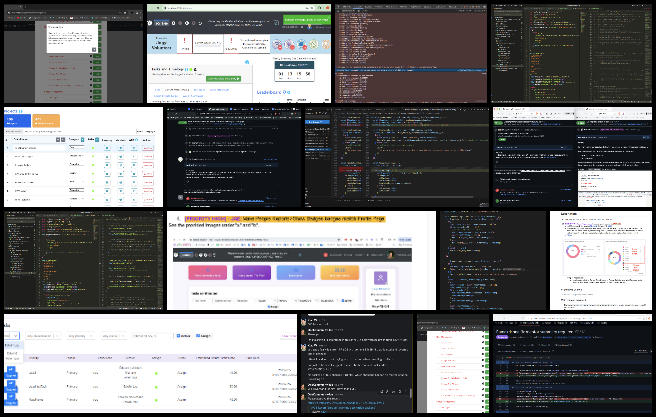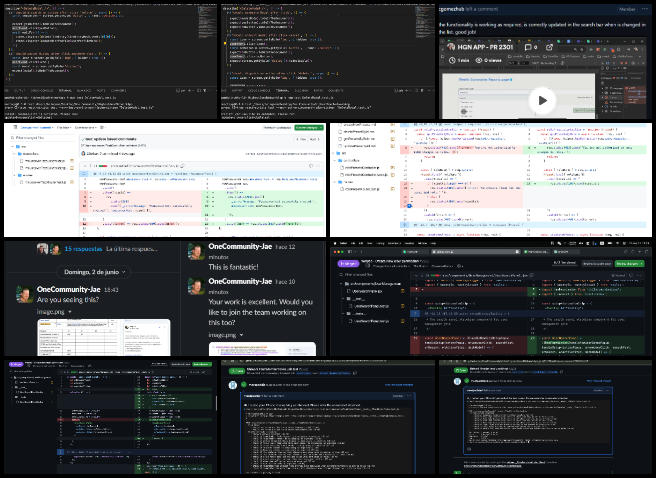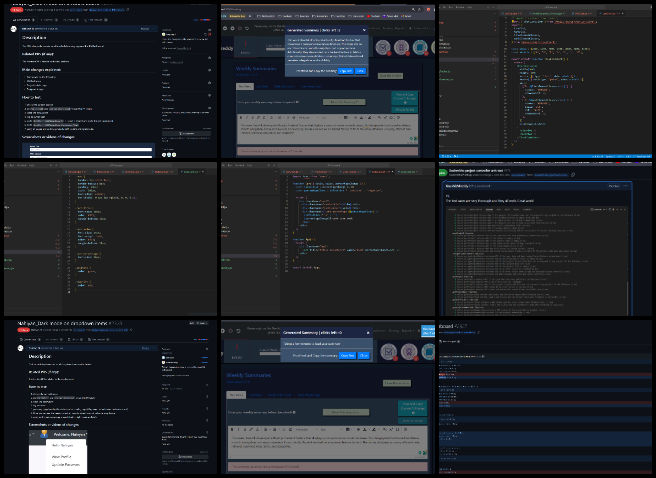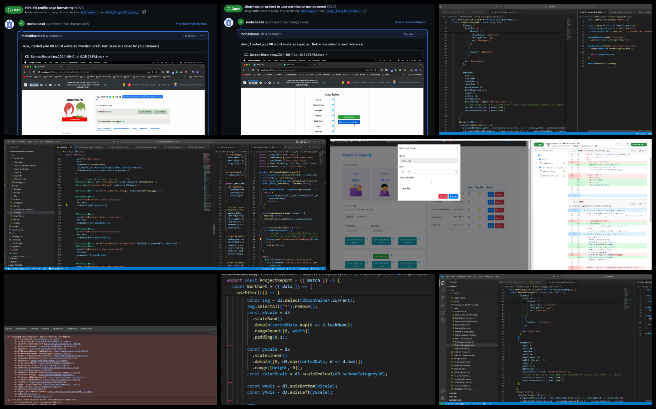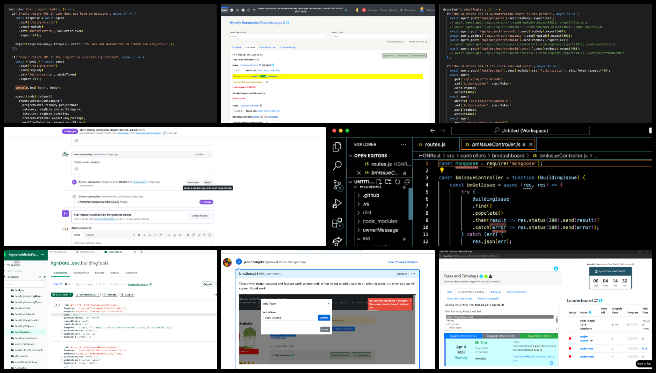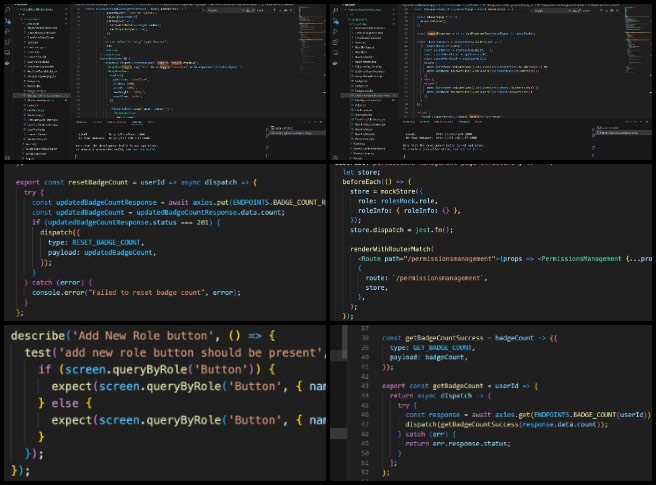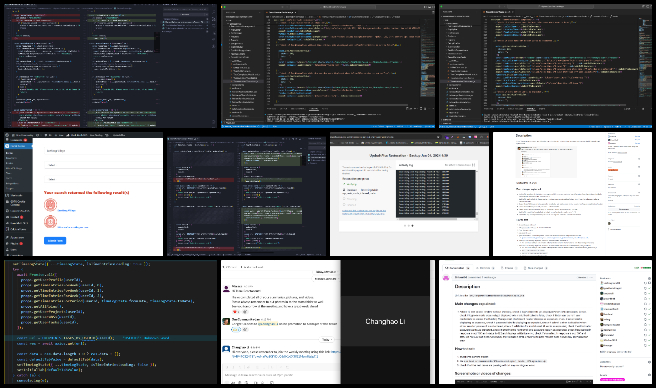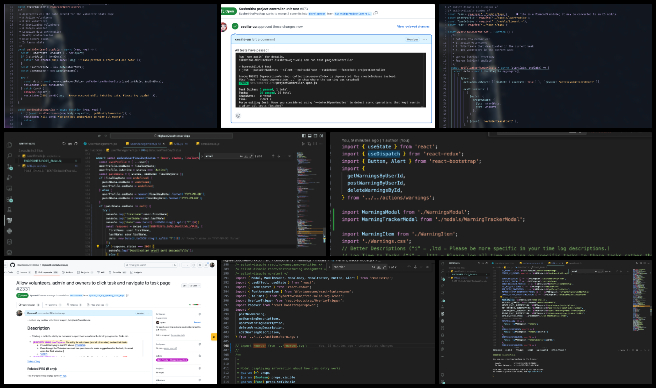Solutioneering Global Sustainability – One Community Weekly Progress Update #586
As an all-volunteer organization, One Community is dedicated to solutioneering global sustainability, including sustainable approaches to food, energy, housing, education, social architecture, and economics. For “The Highest Good of All,” we are creating open source and free-shared solutions that foster fulfilled living while revitalizing our planet. Our model, created by an all-volunteer team, will serve as a blueprint for global collaboration, enabling the creation of teacher/demonstration hubs worldwide.
- Here’s our project overview
- Here’s our world-change methodology
- Here’s how this becomes self-replicating
- Here’s how we are open source and free-sharing all the do-it-yourself designs
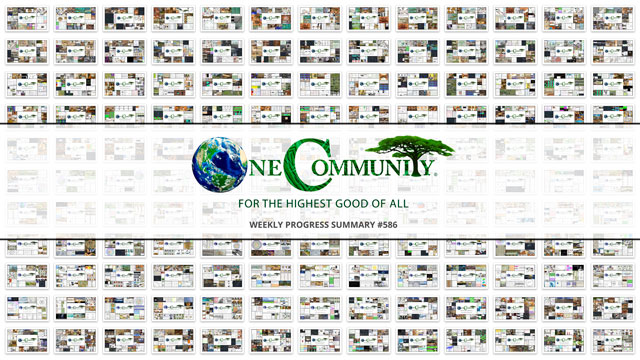
OUR MAIN OPEN SOURCE HUBS
Click on each icon to be taken to the corresponding Highest Good hub page.
One Community’s physical location will forward this movement of solutioneering global sustainability as the first of many self-replicating teacher/demonstration communities, villages, and cities to be built around the world. This is the June 10th, 2024 edition (#586) of our weekly progress update detailing our team’s development and accomplishments:
Solutioneering Global Sustainability
One Community Progress Update #586
DONATE | COLLABORATE | HELP WITH LARGE-SCALE FUNDING
CLICK HERE IF YOU’D LIKE TO RECEIVE AN EMAIL EACH WEEK WHEN WE RELEASE A NEW UPDATE
YOU CAN ALSO JOIN US THROUGH SOCIAL MEDIA
ONE COMMUNITY WEEKLY UPDATE DETAILS
HIGHEST GOOD HOUSING PROGRESS
 One Community is solutioneering global sustainability through Highest Good housing that is artistic and beautiful, more affordable, more space efficient, lasts longer, DIY buildable, and constructed with healthy and sustainable materials:
One Community is solutioneering global sustainability through Highest Good housing that is artistic and beautiful, more affordable, more space efficient, lasts longer, DIY buildable, and constructed with healthy and sustainable materials:
- Learn about how we’ll be Kickstarting this model for solutioneering global sustainability: Our Upcoming Crowdfunding Campaign
- Learn about the different village models solutioneering global sustainability: 7 Sustainable Village Models
- Visit the open source portals for the first two: Earthbag Village OS Hub | Straw Bale Village OS Hub
This week, Charles Gooley (Web Designer) focused on two pages: The Earthbag Village Tools and Equipmentent and Open Source DIY Earth Dam Design & Construction for Water Retention, Pond & Lake Creation. He alphabetized the list of Earthbag Village tools and equipment on the Earthbag Village Tools and Equipment page, and provided anchor links to each item on the list for both the first and second lists, including full URL anchor links in the tool and equipment description. Equipment, tools, and material from the Earthbag Village Tools and Equipment page were added to the Tools and Equipment for Open Source Construction page when necessary, with full URL anchor links provided. Tables were enhanced with headers, and the font size was reduced to ensure they didn’t extend beyond the right margin. Earth constructions like both of these are an important part of solutioneering global sustainability with One Community’s open source plans. See his work in the collage below.
Joseph Osayande (Mechanical Engineer) continued helping finish the Vermiculture Toilet designs. This week, modifications were made to the support system to scale the model and provide a complete view. Adjustments included working on the leg space for the foothold and positioning the winch supporting plate a few inches below the top. Designs for an external support were explored to prevent movement of the left and right support pieces. Additionally, the calculation sheets were improved for greater detail, with explanations of all assumptions and links for any estimates added. The vermiculture toilets and other sustainable human waste processing technologies form the basis of One Community’s open source model for solutioneering global sustainability. See below for some of the pictures related to this work.
Rizwan Syed (Mechanical Engineer) also continued helping finish the Vermiculture Toilet designs. This week, Rizwan implemented design changes to the side and rear structures of the vermiculture chamber system in SolidWorks. He replaced the truss-shaped supports, which previously extended the full span of the chamber, with a shorter structure that terminates at the mid-plane. This adjustment was made to facilitate the operation of the drawer handle in the rear chamber. Rizwan also created new attachment brackets to secure the lateral unistruts to the main chamber. In addition, he resized the drawer handle to ensure it fits precisely at the front drawer’s terminal point and made corresponding updates to the design of the rear barriers. Furthermore, he developed a preliminary slider mechanism equipped with linear bearings, designed to enable the mechanical separator to move laterally. This linear slider mechanism will allow the separators, located above the drawer handle, to slide in and out of the chamber, facilitating the collection of composted material. The vermiculture toilets and other sustainable human waste processing technologies form the basis of One Community’s open source model for solutioneering global sustainability. Here are a few photos showing examples of his work.
AIRCRETE TEAM
The Aircrete Testing Team’s summary, covering their work on Aircrete Compression Testing was managed by John Sullivan (CBU Chemical Engineering Student) and includes Jonathan Crago (Civil Engineering Student), Preston Thompson (Civil Engineering Student), and Tom Sheppard. This week, Tom focused on reviewing previous teams’ work to simplify all previous trials. He spent most of his time analyzing the existing research to build on it. With the team scheduled to gain lab access next week, Tom is planning the next steps. To progress, he reviewed research on the effects of surfactants like Drexel and 7th Gen soap on concrete strength, the mechanics of bubble formation, and how air entrainment admixtures affect the predictability of bubble distribution in concrete. Tom hypothesizes that overdevelopment of the concrete sample causes large, unpredictable air pockets from smaller, more predictable bubbles. Additionally, he identified an issue in the Google Doc where previous teams used a commercially available concrete mix, Quickcrete, which includes aggregate, sand, Portland cement, and additives. This inconsistency in testing parameters needs to be addressed, and the team will develop a consistent testing standard moving forward. Preston and the team were unable to access the lab due to pending approval from the dean, so they focused on researching and updating the final document. Preston’s efforts were centered on aircrete research, where he found articles providing compression results and information on materials affecting aircrete. He contributed to the document by adding sections on waste management, recipes, and incorporating data from the previous team.
Jonathan did his part solutioneering global sustainability as he reviewed the group document to understand the procedures for editing it, made a suggestion on the safety equipment section, and researched aircrete recipes. He examined the previous team’s documents, spreadsheets, and recommended links to videos and articles to better comprehend aircrete and identify controllable variables. Additionally, he uploaded a PDF to OneDrive of a useful article on admixtures. John and the team were unable to begin trials due to pending permission for lab access.
In the interim, John did additional online research to find a more scientific and consistent method of making aircrete, though Google Scholar provided limited information. He also worked on the final document by reviewing the past team’s data and results, adding relevant information where useful. The team expanded the document by including more specific sections, such as waste management. The team’s efforts form the basis of One Community’s open source model for solutioneering global sustainability. See below for some of the pictures related to this work.
DUPLICABLE CITY CENTER PROGRESS
 One Community is solutioneering global sustainability through a Duplicable and Sustainable City Center that is LEED Platinum certified/Sustainable, can feed 200 people at a time, provide laundry for over 300 people, is beautiful, spacious, and saves resources, money, and space:
One Community is solutioneering global sustainability through a Duplicable and Sustainable City Center that is LEED Platinum certified/Sustainable, can feed 200 people at a time, provide laundry for over 300 people, is beautiful, spacious, and saves resources, money, and space:
- Learn about this building and it’s function as part of solutioneering global sustainability: Duplicable City Center Open Source Hub
This week, Chris Blair (GIS Technician/Horticulturist) continued working with GIS data as part of One Community’s Permaculture Design. He finished digitizing plans from images of the master plan by creating new feature classes in ArcGIS Pro. Additionally, with the master plan and Ben Missmer’s maps georeferenced, he began overlaying them to identify potential changes based on Ben’s information. New polygons were added to highlight areas from Ben’s maps that have potential for water collection and flatter areas suitable for building. Chris also reviewed Ben’s website and YouTube channel to understand his mapping process. Proper property modeling and understanding is a foundational part of One Community’s open source model for solutioneering global sustainability. Here are a few photos showing examples of his work.
Nika Gavran (Industrial Designer) continued her work on the Duplicable City Center dormer window installation plans. She prepared instructions for measuring and cutting each piece of wood and insulation, while still refining aspects of the design and assembly. She also began rendering individual sections and categories of pieces, including various measurements of wood and insulation. The Duplicable City Center is a foundational part of One Community’s open source model for solutioneering global sustainability. See below for some of the pictures related to this work.
HIGHEST GOOD FOOD PROGRESS
 One Community is solutioneering global sustainability through Highest Good food that is more diverse, more nutritious, locally grown and sustainable, and part of our open source botanical garden model to support and share bio-diversity:
One Community is solutioneering global sustainability through Highest Good food that is more diverse, more nutritious, locally grown and sustainable, and part of our open source botanical garden model to support and share bio-diversity:
- Learn about the food structures we’ll be building first for solutioneering global sustainability: Hoop House Hub | Aquapini & Walipini Open Source Hub
- See what we’ll be growing as part of solutioneering global sustainability: Gardens & Hoop Houses | Large-scale Structures | Food Forest | TA
This week, the core team continued updating and expanding the Highest Good Food tools, equipment, materials, and supplies document by adding new items, consolidating existing tools onto a master list. This process involved reviewing current tools, adding necessary ones, and collaborating with Haley. Additionally, they participated in a review call to discuss the finalization of the School Integration Program, another key component of One Community’s Highest Good Food Program. Highest Good Food is an important part of solutioneering global sustainability with One Community’s open source plans. See their work in the collage below.
Hayley Rosario (Sustainability Research Assistant) continued helping finalize the Highest Good Food rollout plan and reviewed the Integration and Highest Good Food tools and equipment document. She reviewed all the information required for starting on the web design team, including tutorial videos and the checklist spreadsheet. She also edited and incorporated information from the EDITs document into the actual web page. Highest Good Food is an important part of solutioneering global sustainability with One Community’s open source plans. See her work in the collage below.
HIGHEST GOOD EDUCATION PROGRESS
 One Community is solutioneering global sustainability through Highest Good education that is for all ages, applicable in any environment, adaptable to individual needs, far exceeds traditional education standards, and more fun for both the teachers and the students. This component of One Community is about 95% complete with only the Open Source School Licensing and Ultimate Classroom construction and assembly details remaining to be finished. With over 8 years of work invested in the process, the sections below are all complete until we move onto the property and continue the development and open sourcing process with teachers and students – a development process that is built directly into the structure of the education program and everything else we’re creating too:
One Community is solutioneering global sustainability through Highest Good education that is for all ages, applicable in any environment, adaptable to individual needs, far exceeds traditional education standards, and more fun for both the teachers and the students. This component of One Community is about 95% complete with only the Open Source School Licensing and Ultimate Classroom construction and assembly details remaining to be finished. With over 8 years of work invested in the process, the sections below are all complete until we move onto the property and continue the development and open sourcing process with teachers and students – a development process that is built directly into the structure of the education program and everything else we’re creating too:
- Program Overview: Education Open Source Hub
- How the components work together solutioneering global sustainability: How to use the Education for Life Program
- Lesson Plans for Life – Lesson Plans How-to
- Foundations of Outstanding Leaders, Teachers, and Communicators solutioneering global sustainability
- Curriculum for Life
- Teaching Strategies for Life
- Learning Tools and Toys for Life
- Evaluation and Evolution
This week, Apoorv Pandey (Mechanical Engineer) continued helping with the engineering details for the The Ultimate Classroom part of the Highest Good Education component. He continued updating the AutoCAD title block to meet California state requirements, making additional modifications to ensure compliance, despite encountering software issues. He found a reliable set of guidelines per the California Building Codes, primarily basing his research on a paper published by the city of San Diego in 2018. He also continued his research on reinforcing the straw bale walls alongside the tutorials on STAAD Pro. The One Community model of combining forward-thinking education with sustainably built classrooms like this are an excellent example of solutioneering global sustainability. See the collage below for their work.
Brian Mwoyowatidi (Graduate Structural Engineer) continued his work with the team on the The Ultimate Classroom part of the Highest Good Education component. He researched, reviewed the design details, and examined various types of footings, foundation, and flooring systems to aid in designing the Ultimate Classroom’s footer, foundation and flooring plan. He also gathered and organized essential resources. Using AutoCAD, he reviewed proposed design details and set up the necessary layers for the project, preparing for computer-aided design tasks. In line with our open source strategy, he reviewed the Earthbag Footer, Foundation, and Flooring Plan tutorial to format the Ultimate Classroom’s tutorial. Additionally, Brian studied the structural design concepts including the design criteria according to the ACI-1999/2019, in preparation for a design and detailing meeting with the team and Lead Engineer, Brian Muigai Mwaniki (Structural Engineer), who oversaw the team’s research on straw bale construction and structural design, focusing on the viability and applications of this method. The team’s efforts aimed at integrating sustainable practices into their structural engineering projects. The One Community model of combining forward-thinking education with sustainably built classrooms like this are an excellent example of solutioneering global sustainability. See the collage below for their work.
HIGHEST GOOD SOCIETY PROGRESS
 One Community is solutioneering global sustainability through a Highest Good society approach to living that is founded on fulfilled living, the study of meeting human needs, Community, and making a difference in the world:
One Community is solutioneering global sustainability through a Highest Good society approach to living that is founded on fulfilled living, the study of meeting human needs, Community, and making a difference in the world:
- Read the Highest Good society overview: Highest Good Society
- Learn about the model for fulfilled living and sharing: A Day in the Life
- Learn about the 4 economic models: RBE | For-profit | Non-profit | Entrepreneurship
- Learn about our open source community collaboration and management software: The Highest Good Network
This week, the core team completed over 56 hours managing One Community volunteer-work review not included above, emails, social media accounts, web development, new bug identification and bug-fix integration for the Highest Good Network software, and interviewing and getting set up new volunteer team members. They also shot and incorporated the video above that talks about solutioneering global sustainability and how solutioneering global sustainability is a foundation of the bigger picture of everything One Community is doing. The pictures below shows some of this work.
Aaron Wang (Fundraising Assistant) continued to work on his detailed research on connections with Michael R. Bloomberg, uncovering emails and background information of individuals who may have ties to Bloomberg. This effort is aimed at improving his ability to connect with funders by fostering relationships with relevant individuals involved in these networks. Additionally, he concentrated on identifying candidates with investor backgrounds, seeking to expand potential funding channels. His methodical approach underscores a strategic effort to enhance networking and secure more resources within the philanthropic sector aiding One Community‘s goal for solutioneering global sustainability. The following images showcase his work for the week.
Arun Chandar Ganesan (Volunteer Data Analyst and SEO and Social Media Assistant) continued working on webpages, focusing on the SEO efforts completed by other volunteers. He checked and verified additional pages, revisited and cleared previously abandoned pages, and scheduled LinkedIn posts for the next couple of months. Additionally, Arun coordinated the handover of Facebook and Instagram posting duties efficiently. His work on social media helps One Community to broaden our reach and spread our message about solutioneering global sustainability. The following images show his work for the week.
Prashanth Gowri Shankar Uppudi (Admin and Project Manager) documented the sections of the manual detailing the functionalities related to owner, administrator, and manager accounts. Specifically, he focused on the comprehensive permissions available to manager accounts. This included their abilities in report generation, user management, badge management, project management, work breakdown structures, task management, teams management, and timelog management. He also made necessary corrections and updates to ensure the accuracy of the content, providing clear guidelines on how managers can utilize these permissions to effectively oversee and control various aspects of the system. By editing functionalities and managing permissions, Prashanth contributed to the One Community mission for solutioneering global sustainability. The following images highlights his progress for the week.
ADMINISTRATION TEAM
The Administration Team’s summary, covering their work administrating and managing most of One Community’s ongoing process for solutioneering global sustainability was managed by Sneka Vetriappan (Data Analyst) and includes Durgeshwari Naikwade (Data Analyst), Jessica Fairbanks (Administrative Assistant), Jim Zhang (Administrative Assistant), Olawunmi “Ola” Ijisesan (Administrative and Management Support), Rachna Malav (Data Analyst), Ram Shrivatsav (Data Analyst and Admin assistant), Ratna Meena Shivakumar (Data Analyst and Admin), Ruiqi Liu (Administrative Assistant), T R Samarth Urs (Data Analyst), Vibhav Chimatapu (Data Analyst/Admin Assistant), Xiaolai Li (Administrative Assistant) and Zuqi Li (Administrative Assistant and Economic Analyst). This week, Durgeshwari worked on developing a Figma wireframe for the weekly HR analytics dashboards, incorporating feedback from Jae and Harsh, and delved into documents for the Highest Good Network App phase 3, while also conducting interviews for the software development team. Jessica advanced the work breakdown structures for new positions at Highest Good Food, integrated feedback from Jae, and contributed to the One Community collaboration page with her bio and picture.
Jim completed administrative work with Team Airecrete, Highest Good Housing, and the Duplicable City Center, provided feedback on Xiaolai’s financial model for the Earthbag Village project, and finalized the electrical cost analysis for the tropical atrium and the dome cluster. Ola did her part solutioneering global sustainability as she reviewed the PR team’s work, tracked progress report updates, provided detailed comments, created a business account for Pinterest/Social media live blogs, trained new admin team members, and ensured workspace readiness. Rachna performed her weekly administrative tasks, provided feedback to team members, created the weekly blog and collages, scheduled and handled interviews with potential volunteers, and progressed on her SEO pages, starting her tasks early to stay ahead.
Ram focused on optimizing SEO articles, reviewed and fixed errors from the previous week, and incorporated feedback from the admin team to maintain high-quality work. Ratna managed weekly progress update #585, prepared collages for various teams, reviewed other admins’ work, organized virtual interviews, managed email correspondence, discussed the Analytics document with Arun, scheduled social media posts, and gave final checks on reviewed blogs. Ruiqi did her part solutioneering global sustainability as she completed the review process for the Dev Dynasty and Git-R-Done Teams, performed final checks on blog 585, informed members about their bio announcements, assisted non-responsive members, started the Lightbulbs research project, and reviewed several finished webpages.
Sneka led the team by focusing on SEO Optimization, updating older SEO pages, addressing feedback, managing time log entries, reviewing documents, and ensuring all summaries and collages were updated on the webpage. Samarth managed the PR review team, reviewed their work, provided feedback, optimized blog posts #344 and #345 for SEO, and ensured his blog post was accepted without adjustments. Vibhav continued his administrative duties by reviewing PR team work, creating group summaries and collages, and significantly improving blog scores and keyword densities through SEO optimization. Xiaolai did his part solutioneering global sustainability as he reviewed software team reports, edited summaries and pictures, managed webpage updates, provided feedback on the solar energy project, and contributed to the ESG report for sustainable finance. Zuqi organized the weekly summary for the Graphic Design and Alpha Teams, updated the weekly blog, reviewed other admins’ work, and ensured previous blog pages were optimized for search engine marketing and adhered to checklist standards. One Community’s model for solutioneering global sustainability includes developing and maintaining huge administration team like this. You can see the work for the team in the image below.
GRAPHIC DESIGN TEAM
The Graphic Design Team’s summary was managed by Zuqi Li (Administrative Assistant and Economic Analyst) and included Ashlesha Navale (Graphic Designer), Jasmine Soria (Graphic Designer) and Shayan Afkari (Graphic Designer), covering their work on graphic designs for solutioneering global sustainability. This week, Ashlesha worked on creating nine recipe images-Master Recipe SSWJ for the new Graphic Design Task – Recipe Images for Site Task. She also reworked on fixing recipe images for 10 recipe files and updated them. Additionally, Ashlesha researched and curated a collection of nature-based background images and different theme-based images for creating Social Media Images and created one social media image. Jasmine received feedback on her previous graphics, which required the removal of white borders that had been exported. She worked on three new social media graphics, selecting them from the social media spreadsheet.
Shayan did his part solutioneering global sustainability as he undertook a series of updates and corrections across our social media platforms and website. He revised the fonts used in various social media images to ensure brand consistency, enhance readability, and improve the overall aesthetic appeal. Additionally, he updated and corrected the URLs embedded in these images to ensure they direct users to the appropriate web pages. Shayan also edited the names listed in the website’s biographies section, including correcting spellings, updating names due to personal changes such as marriage, and standardizing the format of name presentation for uniformity. See the Highest Good Society pages for more on how this contributes to solutioneering global sustainability. See the collage below to view some of their work.
HIGHEST GOOD NETWORK PROGRESS
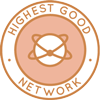 One Community is solutioneering global sustainability through open source Highest Good Network® software that is a web-based application for collaboration, time tracking, and objective data collection. The purpose of the Highest Good Network is to provide software for internal operations and external cooperation. It is being designed for global use in support of the different countries and communities replicating the One Community sustainable village models and related components.
One Community is solutioneering global sustainability through open source Highest Good Network® software that is a web-based application for collaboration, time tracking, and objective data collection. The purpose of the Highest Good Network is to provide software for internal operations and external cooperation. It is being designed for global use in support of the different countries and communities replicating the One Community sustainable village models and related components.
This week, the core team continued their work on the Highest Good Network PRs testing, confirming the fixed PRs. The PRs include the addition of a refresh button to the Weekly Summaries Reports page (PR2316), the ability to log time entries for other users on their timelog pages (PR1412), the correct display of the “New max – personal record award” badge showing the maximum hours logged in a week (PR826), and the hover pointer display for checkboxes or radios (PR2099). They identified unresolved problems, including the improper handling of creating new roles without required role names and permissions (#2031), where newly created roles do not appear in the roles list, and constant issues with viewing “Scheduled Blue Square reasons” and “Scheduled Time off” windows in Dark mode (PR2295), where the font and background colors are both white. Additionally, they reported new bugs: where a white screen appears when accessing Reports â Reports â Team and clicking on a team name, and a timer issue where it stops without a sound alert just before reaching the 5-hour mark, and clicking the “Continue” button is not working. The Videos documenting these issues were also provided. See the Highest Good Society and Highest Good Network pages for more on how this relates to solutioneering global sustainability. The collage below shows some of their work.
ALPHA SOFTWARE DEVELOPMENT TEAM
This week, the Alpha Team’s summary, covering their work on the Highest Good Network software was managed by Sucheta Mukherjee (Software Developer) and includes Anand Seshadri (Software Engineer), Jordy Corporan (Software Engineer), Lin Khant Htel (Frontend Software Developer) and Nathalia Carnevalli (Full Stack Software Developer). The Highest Good Network software is how we will manage and measure our processes for solutioneering global sustainability across our social architecture, construction, production, and maintenance processes. This week Anand worked on Dark Mode Modals change in the Reports page and made progress on multiple features. He completed the Add Task Modal’s Date error display feature by fixing the validation for error fields and ensuring errors are cleared when reopening the modal using a hook, and raised a PR for this feature, PR 2335. Anand also started working on a new feature to fix the horizontal scrollbar issue on responsive screens, tested two related PRs, PR 1809 and PR 2002, and fixed the issue in the modal header within the Teams component.
Lin performed unit testing for the DashboardController, focusing on the getPromptCopiedDate and leaderboard data functions. He also covered documentation for software team management in preparation for taking on management roles. Nathalia did her part solutioneering global sustainability as she completed two tasks of varying priority, fixing discrepancies in the total hours for the project on the Project Report page (PR #2315) and making the blue square description box bigger and auto-fit (PR #2333), and made pull requests for both tasks. Jordy expanded his proficiency in unit testing, focusing on Jest while developing the final tests for the rolesController, ensured all functions in the rolesController were tested, and opened a new PR#981.
Sucheta focused on reviewing and addressing change requests but was unable to resolve the issue due to significant incompatibilities between the development branch changes and the current code in the PR. Additionally, She worked on a hotfix for a previous PR, which involved changing the length of an input field in the addTaskModal. See the Highest Good Society and Highest Good Network pages for more on how this relates to solutioneering global sustainability. View some of the team’s work in the collage below.
BADGES BUGS SOFTWARE DEVELOPMENT TEAM
The Badges Bugs Team’s summary overseeing advancements in the Highest Good Network software was managed by Summit Kaushal (Backend Software Developer) and includes Shaofeng Li (Software Engineer) and Xiao Zhang (Software Engineer) The Highest Good Network software is how we’ll be managing and objectively measuring our process for solutioneering global sustainability through our social architecture, construction, production, and maintenance processes. This week, Summit spent time debugging the test for PR 665, commenting out some lines of code within the test file, and determining the issue related to a function. While debugging the function, an else statement was added for the addbadge call, but the results still output 5 instead of 4, indicating a potential issue within one of the checks in the function. Summit removed comments from PR 947 and modified the code. An additional video was created to test PR 947. He updated the description of PR 947 and sent a message to the team for review. Time was also allocated to familiarizing with the manager role, debugging a logical error in the xhoursxweek task, reviewing the badge component description for the xhoursxweek task, and searching for new team members. Xiao completed the documentation of badge testing results, reviewed Summit’s pull request, and assisted Shaofeng with the quality checklist. The documentation involved detailing the outcomes of the badge tests, ensuring accuracy and clarity for future reference. In reviewing Summit’s pull request, the user focused on identifying and correcting errors, improving code functionality, and enhancing overall project integrity. By helping Shaofeng with the quality checklist, the user contributed to the verification of project standards and requirements, ensuring all components met the necessary criteria before final approval. Each task was aimed at maintaining and elevating the quality of the project deliverables. See the Highest Good Society and Highest Good Network pages for more on how this relates to solutioneering global sustainability. View some of the team’s work in the collage below.
BINARY BRIGADE SOFTWARE DEVELOPMENT TEAM
The Binary Brigade Team’s summary overseeing advancements in the Highest Good Network software was managed by Huijie Liu (Software Engineer) and includes Peizhou Zhang (Software Engineer). The Highest Good Network software is how we’ll be managing and objectively measuring our process for solutioneering global sustainability through our social architecture, construction, production, and maintenance processes. This week, Huijie debugged the controller code for recalculating category hours and performed a one-time recalculation on the database for all users by sending a request using Postman. She also made a backup of all previous data, committed the recent code changes, and described the updates in a video response. Peizhou resolved the issue where hovering over the “Save Changes” button under Profile->Teams caused the text to disappear by commenting out the problematic code instead of deleting it, preserving it for potential future style changes. After testing the code, Peizhou raised a pull request. Additionally, he fixed a formatting error with profile images, allowing users to upload long images without affecting the page layout or creating extra white space. See the Highest Good Society and Highest Good Network pages for more on how this relates to solutioneering global sustainability. View some of the team’s work in the collage below.
BLUE STEEL SOFTWARE DEVELOPMENT TEAM
The Blue Steel Team’s summary, presenting their work on the Highest Good Network software was managed by Jingyi Jia (Software Engineer, Team Manager), and includes Bhuvan Dama (Full stack Developer), Imran Issa (Software Developer), Jay Srinivasan (Software Engineer), Parth Rasu Jangid (Software Developer), Ramakrishna Aruva (Software Engineer), Tzu Ning “Leo” Chueh (Software Engineer), and Xiao Wang (Software Engineer). The Highest Good Network software is how we’ll be managing and objectively measuring our process for solutioneering global sustainability through our social architecture, construction, production, and maintenance processes. This week, Imran worked on a new permission that allows users access to the user management page with full functionality, focusing mainly on frontend updates to align with the new permission.
Jay addressed a bug affecting the color accuracy in admin-level user pie charts, enhancing the clarity and usefulness of people’s reports. He submitted a pull request for this fix and began investigating another issue with inconsistent badge information displays. Ramakrishna, after receiving feedback, made adjustments to his tasks, committed the changes, and submitted pull requests. He continued refining the team code functionality, ensuring testing and documentation are in place.
Xiao tackled the white screen issue by refactoring the Project system and implementing an archive functionality, which marks related WBS, tasks, and time entries as inactive, thus resolving data retrieval issues. Jingyi did her part solutioneering global sustainability as she finalized the “editHeaderMessage” permission feature, focusing on backend enhancements to allow specific volunteers to edit system header messages. She also revisited the permission controls for badges, implementing backend improvements that eliminated the need for frontend changes, detailed in HGNREST #974.
Parth continued his efforts on unit testing, particularly addressing challenges with error handling in tests, while also reviewing and providing feedback on several pull requests. Bhuvan worked on enhancing the test coverage and functionality of TableFilter.js, alongside addressing Git branch issues that affected project builds. Tzu Ning did his part solutioneering global sustainability as he fixed a critical issue in the TimeEntry component that caused white screen errors and improved the responsiveness and stability of the edit functionality in task components. See the Highest Good Society and the Highest Good Network pages to learn more on how this contributes to solutioneering global sustainability. See below to view their work.
CODE CRAFTERS SOFTWARE DEVELOPMENT TEAM
The Code Crafters Team’s summary, covering their work on the Highest Good Network software, was managed by Anirudh Ghildiyal (Software Engineer) and includes Carlos Gomez (Full-stack Software Developer), Meet Padhiar (Software Engineer), Weiyao Li (Software Engineer) and Xiaoyu Chen (Software Engineer). The Highest Good Network software is how we’ll manage and objectively measure our process for solutioneering global sustainability through our social architecture, construction, production, and maintenance processes. Anirudh G resolved issues faced by teammates, and provided updates on their progress, helping to connect them with other team members to expedite issue resolution. He also reviewed and made requested changes on the DeleteModal component. Carlos began improving PR2310, developed and submitted a toggle similar to the one on the Weekly Summaries Reports page, and a “show only active members” feature.
Carlos also reviewed PR2316, ensuring that the refresh button was clickable and displayed “Successfully Updated Weekly Summaries Report.” Meet reviewed numerous pull requests, mostly related to major UI changes and unit tests. He also finished functional testing of all the features related to the merged pull requests into the development branch, guaranteeing adherence to best practices and confirming the operation of the application. Weiyao worked on the “add roles” feature, which involved challenges with assigning permissions during the creation process, requiring edit access to create roles with permissions. Xiaoyu did her part solutioneering global sustainability as she revised the rolePreset and mouseover tests following suggestions from Diego and completed the final review of a pull request based on Jae’s requirements. Xiaoyu also finalized the createPopupEditorBackup and getAllPopupEditorBackup unit tests, wrote documentation for the create, getAll, and getById methods, drafted the updatePopupEditorBackup and router API for the getAll popup feature, and completed the integration test, building and submitting a pull request for review by Diego. See the Highest Good Society and Highest Good Network pages for more on how this relates to solutioneering global sustainability. The collage below shows some of this work.
DEV DYNASTY SOFTWARE DEVELOPMENT TEAM
The Dev Dynasty Team’s summary, covering their work on the Highest Good Network software, was managed by Nahiyan Ahmed (Full Stack Software Developer) and includes Kaushik Malikireddy (Full Stack Developer Intern), and Harsh Bodgal (Software Engineer). The Highest Good Network software is how we’ll manage and objectively measure our process for solutioneering global sustainability through our social architecture, construction, production, and maintenance processes. Harsh focused on the Volunteer Summary Report component development, setting up the structure, and creating the file organization for the charts and other parts of the dashboard. Additionally, Harsh began integrating charts using mock data into the local Frontend Repository and coordinated with the team to monitor the progress of the work.
Kaushik added a Redux store managed value to limit the “Write for me” button clicks to three times every five minutes along with an alert. He worked on setting the timeout value from anywhere in the application, added dark mode for the generated summary modal, and removed quotes from the generated text. He tested and assisted developers on the Slack channel, fixed the Gemini AI API call looping issue, identified a new task to keep the rehireable checkbox always ticked, and requested it be assigned. He pushed two fixes to the Frontend GPT pull request, updated the button name for copying text, updated the pull request description to show how to generate an API key and AI prompt used to generate summaries, and searched for new features or bugs to work on. Kaushik also reviewed two Pull requests. Nahiyan did his part solutioneering global sustainability as he completed two pull requests: PR 2327, which involved implementing dark mode on all available pages of the BM dashboard (still in development with limited pages), and PR 2328, which implemented dark mode on the dropdown located within the header component to ensure dark mode consistency throughout the website. Additionally, Nahiyan redesigned the tasks table to make it more responsive to different viewports and ensure columns and rows are easily identifiable. See the Highest Good Society and Highest Good Network pages for more on how this relates to solutioneering global sustainability. The collage below shows some of this work.
EXPRESSERS SOFTWARE DEVELOPMENT TEAM
The Expressers Team’s summary, covering their work on the Highest Good Network software, was managed by Shereen Punnassery (Full Stack Software Engineer) and includes Christy Guo (Software Engineer), Jiayu Huang (Software Engineer), KyoSook Shin (Software Engineer) and Wenbo Liu (Software Engineer Volunteer). The Highest Good Network software is how we’ll be solutioneering global sustainability throughout our social architecture, construction, production, and maintenance processes. This week, Christy spent time to optimize the UI for the Hour Task Visualization, updated the chart style to ensure coherence with other components. Jiayu did her part solutioneering global sustainability as she worked on fixing the process for manually adding lost hours for past years of volunteers, completed the functionality for adding, editing, and deleting lost time for individuals, fixed the bug, and submitted a pull request on GitHub, and also he reviewed and finalized PR #1801, #1847, and #1855.
KyoSook analyzed the existing Dashboard and weekly report, added the BMTimelogger component to the routes.js file and integrated the current date feature into BMTimeLogger.jsx, also she created BMTimeLogSelectProject.jsx, BMTimeLogProjectDetails.jsx, and BMTimeLogger.css files in the front end and bmTimeLoggerController.js and bmTimeLoggerRouter.js files in the backend for the time logger feature. Shereen worked on issues with the Equipment List View. She did an analysis and found that the fundamental cause of the issue stemmed from a missing function in the controller. Additionally, an issue was found in the equipmentAction file. She worked on the equipment controller to fetch the list of equipment from the database. Furthermore, Shereen created the controller function to fetch equipment list data from the database. Wenbo did a review of pull requests #981 and #2169, focused on testing for frontend and backend, while the functionality of pull request #2330 did not work as expected, prompting a request for change. Pull requests #2250 and #2298 were reviewed and found to be working as expected. Pull request #2263 was approved, whereas pull request #974 was requested to change. See the Highest Good Society and Highest Good Network pages for more on how this relates to solutioneering global sustainability. See the collage below for the team’s work this week.
GIT-R-DONE SOFTWARE DEVELOPMENT TEAM
The Git-R-Done Team’s summary, covering their work on the Highest Good Network software, was managed by Hiral Soni (Full Stack Developer) and includes Chris Chen (Software Engineer Intern), Malav Patel (Software Developer), Nishitha Shetty (Software Engineer), Rhea Wu (Software Engineer), Sushmitha Prathap (Software Developer) and Youyou Zhang (Software Developer). The Highest Good Network software is how we’ll be managing and objectively measuring our process for solutioneering global sustainability across our social architecture, construction, production, and maintenance processes. This week, Chris added a refresh button icon and implemented the handleRefresh function to retrieve the latest summaries in the Weekly Summaries Report, checked into the development branch as frontend PR #2316. Testing confirmed the refresh button’s functionality and the “Successfully Updated Weekly Summaries Report” message.
Hiral resolved the conflict on branch #2225 for merging and added pagination functionality to the weekly summary page, enhancing its efficiency and speed for the branch focused on weekly summary report page efficiency. Malav did his part solutioneering global sustainability as he fixed bugs in the DELETE_TIME_ENTRY_OTHERS feature, restricted the permission of volunteers to delete owners/admins/managers’ Time Entry logs, and pushed changes to their branch. He completed the task and testing, spent 20 hours on tasks, solved various issues during bug fixing, and communicated with Jae regarding some errors that needed fixing before raising a PR. Nishitha reviewed 10 pull requests, provided comments and screenshots for all 10 PRs, and was unable to run 2 PRs locally. Rhea tested the building task, updated the codebase, modified the route’s endpoint for the Issue router, and continued working on 9.2.4 Routing and controllers for the Log Equipment form. Sushmitha worked on integration testing for the project controller, writing initial test cases, fixing a type error, creating test cases for delete, put, and post functions, resolving an error related to port and permissions, reviewing mongo-helper code, and understanding the test helper files. She also worked on tests for getAllProjects and getUserProjects functions and compiled her weekly summary.
Youyou began her first task on the development team, completed five pull request reviews, enabled key binding of Command (Mac) / Control (Windows) + profile icon to open the user profile in a new tab, and researched JavaScript for binding a different onclick event. She did her part solutioneering global sustainability as she tested the functionality, sought clarification from Jae, reviewed and approved PR 2333 for auto-fitting input field length in the Blue Square panel, PR 2298 for adding a spinning wheel on the Reports page and UX suggestion for a selectable date range, PR 2335 for adding date validation on the task panel, requested changes to PR 2331 for allowing suggestions to be visible to other accounts on the same task and approved PR 2332 for adding an error popup when trying to add users to a team they are already part of, confirming it worked with an owner account. See the Highest Good Society and Highest Good Network pages for more on how this relates to solutioneering global sustainability. See the collage below for the team’s work this week.
MOONFALL’S SOFTWARE DEVELOPMENT TEAM
Moonfall Team’s summary, covering their work on the Highest Good Network software, was managed by Lu Wang (Software Engineer) and includes Abdelmounaim “Abdel” Lallouache (Software Developer) and Jiadong Zhang (Software Engineer). The Highest Good Network software is how we’ll be managing and objectively measuring our process for solutioneering global sustainability throughout our social architecture, construction, production, and maintenance processes. Abdelmounaim focused on refining the solution for assigning recipients for blue square emails. He implemented blue square email BCC functionality on the user profile page, ensuring its visibility is restricted to owners only. Jiadong focused on the dashboard, specifically on replacing the badge and refactoring the front-end functions for badge management. Lu did her part solutioneering global sustainability as she concentrated on rewriting code and fixing bugs in the unit tests. During the testing phase, she rewrote the selector functions, chart functions, and other related components. Additionally, Lu managed assistant team duties, including writing the weekly report and reviewing teammates’ work. See the Highest Good Society and Highest Good Network pages for more on how this relates to solutioneering global sustainability. Look below for a collage of their work.
REACTONAUTS’ SOFTWARE DEVELOPMENT TEAM
Reactonauts’ Team’s summary, covering their work on the Highest Good Network software, was managed by Changhao Li (Software Engineer) and includes Changhao Li (Software Engineer), Dhairya Mehta (Software Engineer), Hetvi Patel (Full Stack Developer), Hoang Pham (Software Developer), Peterson Rodrigues (Full-Stack MERN Stack Developer), Shengwei Peng (Software Engineer), Shiwani Rajagopalan (Software Engineer) and Vikram Badhan (Software Engineer). The Highest Good Network software is how we’ll be managing and objectively measuring our process for solutioneering global sustainability throughout our social architecture, construction, production, and maintenance processes. Changhao worked on team management, PR reviews, and unit test development. For team management, Changhao hosted the weekly meeting for the team and created the weekly team pic folder to upload progress screenshots and videos. In terms of PR reviews, Changhao reviewed newly released PRs and tested them in the local environment.
Dhairya focused on fixing the “Fix Projects find user function” task, identifying the root cause and developing a sort and search function to optimize user assignment processes. Hetvi did her part solutioneering global sustainability as she reviewed the functionality of search engines on the Earthbag Village page and checked the expired Caldera Forms plugin. She researched alternative plugins to replace Caldera Forms and tested Fluent Forms on a local server to ensure it provided the same functionality. Hoang tackled a performance issue in marking tasks as done, aiming to reduce wait time, while also reviewing past pull requests and resolving comments and conflicts on PRs #2163 and #2187. Peterson fixed a bug in the dashboard section, adjusting default tab settings based on user type.
Shengwei continued working on the backend implementation to protect admin accounts. He added auditing features and fixed some minor bugs for the task. Shiwani did her part solutioneering global sustainability as she addressed three tasks: TimeEntriesViz, TeamMemberTasks, and TeamReport unit tests, modifying test cases to ensure correct functionality and raising PRs #2321, #2322, and #2324. Vikram concentrated on unit testing for WeeklySummaryOptions.jsx and ToggleSwitchContainer.jsx files, ensuring component functionality and reliability, alongside contributing to pull request reviews and submissions. See the Highest Good Society and Highest Good Network pages for more on how this relates to solutioneering global sustainability. Look below for pictures of this work.
SKYE’S SOFTWARE DEVELOPMENT TEAM
Skye’s summary, covering their work on the Highest Good Network software, was managed by Luis Arevalo (Front End Developer) and includes Abi Liu (Software Engineer), Bhuvaneswari Gnanasekar (Software Engineer), Hui Kong (Software Engineer), Kyrene Flores (Software Engineer) and Mengtian Chen (Software Engineer). The Highest Good Network software is how we’ll be managing and objectively measuring our process for solutioneering global sustainability throughout our social architecture, construction, production, and maintenance processes. Abi assisted Luis in troubleshooting an error encountered while testing the inventory controller. Abi also revamped the backend APIs to meet new requirements for the overview reports page, which included creating an efficient data aggregation query to obtain volunteer statistics.
Bhuvana focused on setting up the API endpoint for the project. Additionally, he discussed with team members to gather insights and potential solutions for the API endpoint configuration. Hui Kong (Full-stack Software Engineer) read “Bugs and Needed Functionalities” and learned how to create a new Pull Request in GitHub. Hui did her part solutioneering global sustainability as she reviewed nine PRs, covering both frontend and backend aspects, as well as frontend and backend pairs. Kyrene addressed a bug affecting volunteers’ ability to navigate to their tasks, leading to the creation of suggestion pages. Upon reviewing permissions set in the HGNRest backend for different roles, she discovered that volunteers lacked the necessary ‘suggest’ permission. She added this permission to the protected route object, enabling volunteers to navigate through the protected route. Luis resolved the issue with the inventoryController testing. He then focused on creating a new pull request (PR) for the feature that allows the editing and addition of new warnings.
Mengtian learned how to write unit tests and created a Jest unit test for the NotificationCard component. The test verifies that the component renders correctly, displaying the notification message and sender information properly. See the Highest Good Society and Highest Good Network pages for more on how this relates to solutioneering global sustainability. See the collage below for some of their work.
SOFTWARE PR REVIEW TEAM A-L
The PR Review Team’s summaries for team members’ names starting with A-L and covering their work on the Highest Good Network software was managed by Vibhav Chimatapu (Data Analyst/Admin Assistant). The Highest Good Network software is a foundation of what we’ll be using to measure our results for solutioneering global sustainability. This week’s active members of this team were: Akshit Sharma (Software Engineer), Carl Bebli (Software Engineer), Chunyun Zhang (Software Engineer), Deepthi Kannan (Software Engineer), Jatin Agrawal (Software Engineer), Jinxiong You (Software Engineer), Kavil Rajendra Jain (Volunteer Software Engineer), Kurtis Ivey (Software Engineer) and Logeshwari Renu (Software Engineer). They reviewed all the Highest Good Network PRs (Pull Requests) shared in this week’s update. Learn more about how the Highest Good Network will measure and assist in solutioneering global sustainability in the Highest Good Network open source hub. The collage below shows a compilation of the work from this team.
SOFTWARE PR REVIEW TEAM M-Z
The PR Review Team’s summary for team members’ names starting with M-Z and covering their work on the Highest Good Network software was managed by Olawunmi Ijisesan (Administrative and Management Support) and Samarth Urs (Administrative Assistant and Data Analyst). The Highest Good Network software is a foundation of what we’ll be using to measure our results of solutioneering global sustainability. This week’s active members of this team were: Nathan Hoffman (Software Engineer), Olga Yudkin (Software Engineer), Shrada Chellasami (Software Engineer), Sichun Wang (Software Engineer), Sri Sudersan Thopey Ganesh (Software Engineer), Tianyang Leng (Software Engineer), Vijeth Venkatesha (Full Stack Developer), Yiyun Tan (Software Engineer) and Zijie Yu (Software Engineer). They reviewed all the Highest Good Network PRs (Pull Requests) shared in this week’s update. Learn more about how the Highest Good Network will measure and assist in solutioneering global sustainability in the Highest Good Network open source hub. The collage below shows a compilation of the work from this team.
AND WE PRODUCED THIS WEEKLY UPDATES BLOG – CLICK HERE TO SUBSCRIBE
FOLLOW ONE COMMUNITY’S PROGRESS (click icons for our pages)
INVESTOR PAGES
GET INVOLVED
DONATE | WAYS ANYONE CAN HELP | MEMBERSHIP
CLICK HERE FOR ALL PAST UPDATES
 One Community
One Community


